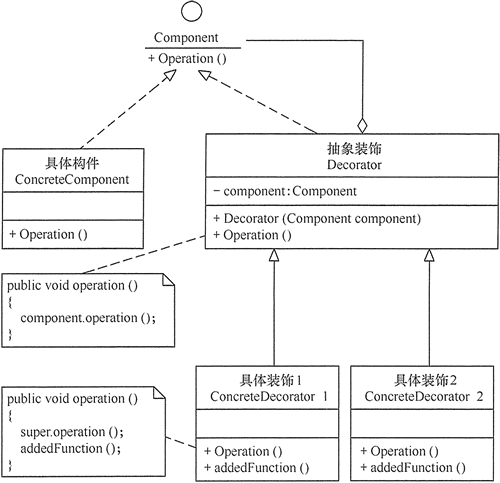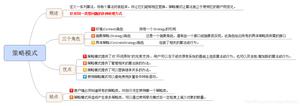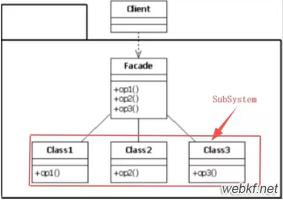后浪 来学习吧!设计模式【10】装饰模式
设计模式【10】装饰模式
定义
动态地给一个对象添加一些额外的职责。就扩展功能而言, 它比生成子类方式更为灵活。
主要解决什么
一般的,我们为了扩展一个类经常使用继承方式实现,由于继承为类引入静态特征,并且随着扩展功能的增多,子类会很膨胀。
结构
- 抽象构件(Component)角色:定义一个抽象接口以规范准备接收附加责任的对象。
- 具体构件(Concrete Component)角色:实现抽象构件,通过装饰角色为其添加一些职责。
- 抽象装饰(Decorator)角色:继承抽象构件,并包含具体构件的实例,可以通过其子类扩展具体构件的功能。
- 具体装饰(ConcreteDecorator)角色:实现抽象装饰的相关方法,并给具体构件对象添加附加的责任。

实现
package decorator;publicclassDecoratorPattern
{
publicstaticvoidmain(String[] args)
{
Component p=new ConcreteComponent();
p.operation();
System.out.println("---------------------------------");
Component d=new ConcreteDecorator(p);
d.operation();
}
}
//抽象构件角色
interfaceComponent
{
publicvoidoperation();
}
//具体构件角色
classConcreteComponentimplementsComponent
{
publicConcreteComponent()
{
System.out.println("创建具体构件角色");
}
publicvoidoperation()
{
System.out.println("调用具体构件角色的方法operation()");
}
}
//抽象装饰角色
classDecoratorimplementsComponent
{
private Component component;
publicDecorator(Component component)
{
this.component=component;
}
publicvoidoperation()
{
component.operation();
}
}
//具体装饰角色
classConcreteDecoratorextendsDecorator
{
publicConcreteDecorator(Component component)
{
super(component);
}
publicvoidoperation()
{
super.operation();
addedFunction();
}
publicvoidaddedFunction()
{
System.out.println("为具体构件角色增加额外的功能addedFunction()");
}
}
程序运行结果如下:
创建具体构件角色
调用具体构件角色的方法operation()
---------------------------------
调用具体构件角色的方法operation()
为具体构件角色增加额外的功能addedFunction()
Android中的应用
Activity继承自ContextThemeWrapper,ContextThemeWrapper继承自ContextWrapper,ContextWrapper才是继承自Context。ContextWrapper就是我们找的装饰者。
总结
**优点:**装饰类和被装饰类可以独立发展,不会相互耦合,装饰模式是继承的一个替代模式,装饰模式可以动态扩展一个实现类的功能。
**缺点:**多层装饰比较复杂。
使用场景:
1、扩展一个类的功能。
2、动态增加功能,动态撤销。
**注意事项:**可代替继承。
参考资料
JAVA设计模式总结之23种设计模式
装饰器模式
装饰模式(装饰设计模式)详解
感谢您阅读本文,希望能在微信公众号(见下方二维码)、掘金、简书、CSDN一起交流。

以上是 后浪 来学习吧!设计模式【10】装饰模式 的全部内容, 来源链接: utcz.com/a/31209.html






